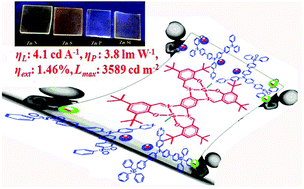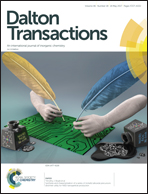Bis-ZnII salphen complexes bearing pyridyl functionalized ligands for efficient organic light-emitting diodes (OLEDs)†
Abstract
Inspired by the emissive features of ZnII complexes based on bis-Schiff base ligands, bis-ZnII salphen complexes bearing pyridyl functionalized ligands have been successfully synthesized. Their photophysical features, electrochemical behavior and electroluminescent (EL) properties have been investigated in detail. The functionalized bis-ZnII salphen complexes can exhibit high thermal stability up to 417 °C, and their photoluminescence (PL) spectra show a maximal emission wavelength peak at ca. 565 nm both in solution and PMMA doped films. The PL investigation of the neat films for these functionalized bis-ZnII salphen complexes indicated that the pyridyl functionalized ligands can effectively reduce the degree of molecular aggregation to enhance their emission intensity. Taking advantage of the charge carrier injection/transporting ability of the pyridyl functionalized ligands and their dendritic design, the optimized EL devices fabricated by a simple solution-processing method can achieve a peak luminance (Lmax) of 3589 cd m−2, a maximal external quantum efficiency (ηext) of 1.46%, a maximal current efficiency (ηL) of 4.1 cd A−1 and a maximal power efficiency (ηp) of 3.8 lm W−1. These results should afford important instructions for exploiting high performance fluorescent emitters based on dinuclear ZnII complexes.



 Please wait while we load your content...
Please wait while we load your content...